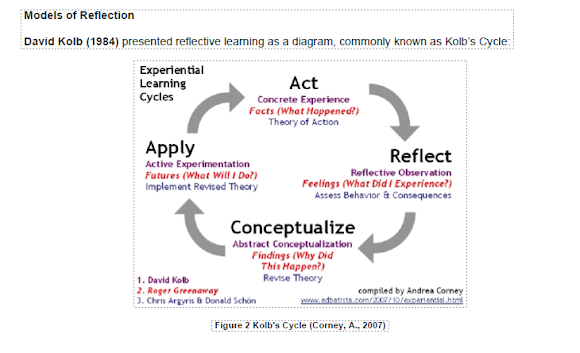There are four parts to critical reflection:
DESCRIBE recognise how we are teaching
(what did you do and why? What are the concrete events- actions and reactions. Do this in my own words.)
INFORM consider ways that we are teaching and experience that we and others have of that teaching
(what meaning do these teaching events that I've just described have for myself and learners)
CONFRONT ask questions about the whys and hows of the way we teach
(how did things come to be this way? What assumptions/values are at the root of this? Are these assumptions correct?)
RECONSTRUCT use the answers to plan for the future and learn from them
(Could I have done this differently? Theoretically, what would that look like?)
This reminds me of lessons from Landmark regarding what you know you know, what you know you don't know, and what you don't know you don't know.
Levels of Reflection
Reflection-in-action comes as I'm quickly responding to changing and unpredictable situations in the classroom like software/hardware issues or student response to the lesson.
Reflection-on-action is afterwards and is more in depth. This is often a forgotten step.
Task for Reading 1: read first two pages of "Critical Reflections on Teaching" .
Answer:
What is Reflective Teaching? Looking back and evaluating what happened so you can move forward and improve.
What are Levels of Reflection? You've got to reflect in the moment to things that are happening quickly (reflection in action) and then go back and evaluate what could happened, what could have been done differently, how you're going to proceed in future (reflection ON action).
Choose 3 of the following and provide an example of when I have used this level of reflection.
Rapid Reflection: I came into the classroom and found that I was not able to use the overhead projector because there was a problem with the associated tutor computer. I quickly had the class convene on Discord which I was able to access from a student computer and ran the lesson from there so everyone could see what was happening.
Repair: I had planned to spend one hour each on 3 separate steps of the process. Students cues were that they were not keeping up and needed more time to put lessons into practice. I chose 2 processes and spent an hour and a half of the section on each one and let the class try them before moving onto the next.
Review: A group of students did not seem to be "getting" the information or implementing it. I thought about it and discussed it with a colleague who was also teaching them. We were able to devise a strategy to support the students comprehension across two classes.
Research:
Re-theorising and reformulating:
Professional Development for Academics Involved in Teaching. (n.d.). Critical Reflections on Teaching. ProDAIT. www.prodait.org
Provided as part of SIT2LRN's US7110 paper "Critically Evaluate and Improve own Knowledge and Practice in Adult Education and Training"
Stix, A., & Hrbek, F. (2006). Teachers as classroom coaches : How to motivate
students across the content areas. ProQuest Ebook Central https://www.proquest.com
University College of Dublin. (n.d.). How to be critical when reflecting on your teaching.
http://www.ucdoer.ie/index.php/How_to_be_Critical_when_Reflecting_on_Your_Teaching
According to Brookfield (1988), four activities are central to critical reflection:
- Assumption analysis – This is the first step in the critical reflection process. It involves thinking in such a manner that you challenge your own beliefs, values, cultural practices and social structures. The purpose of this is not, necessarily, to overthrow these beliefs and values but, rather, to assess their impact on our daily proceedings and thus be able to see more clearly causal relationships. Assumptions are our way of seeing reality and but if we are unaware of them they can trap us into false reasoning.
- Contextual awareness – Realizing that our assumptions are socially and personally created in a specific historical and cultural context.
- Imaginative speculation – Imagining alternative ways of thinking about phenomena in order to find better ways of doing things. This is really what is meant by the oft-use but little understood phrase “thinking outside the box”.
- Reflective skepticism - Questioning of universal truth claims or unexamined patterns of behaviour and interaction through the prior three activities (assumption analysis, contextual awareness, and imaginative speculation). It is the ability to think about a subject so that taken-for-granted assumptions are suspended or temporarily rejected in order to establish the truth of an analysis or the viability of a proposition.
Brookfield, S. D. (2017). Becoming a critically reflective teacher. ProQuest Ebook Central https://www.proquest.com
Stephen Brookfield shows how you can uncover and assess your assumptions about practice by viewing them through the lens of your students' eyes, your colleagues' perceptions, relevant theory and research, and your own personal experience. Practicing critical reflection will help you... Align your teaching with desired student outcomes See your practice from new perspectives Engage learners via multiple teaching formats Understand and manage classroom power dynamics Model critical thinking for your students Manage the complex rhythms of diverse classrooms
Brookfield, S. D. (2015). The skillful teacher : On technique, trust, and responsiveness in the classroom. ProQuest Ebook Central https://www.proquest.com
Energize your classrooms with these key techniques for college teaching Students say the best teachers get them excited about learning, stretch their thinking, and keep them actively involved in class. But with increasingly diverse classrooms and constantly changing technology, each semester throws up new challenges for engaging students. Discover how to keep your teaching, and your students, energized with The Skillful Teacher, a practical guide to effective techniques, approaches, and methods for today's college classrooms.Professional Development for
Academics Involved in Teaching. (n.d.). Critical Reflections on Teaching. ProDAIT. www.prodait.org Provided
as part of SIT2LRN's US7110 paper "Critically Evaluate and Improve own
Knowledge and Practice in Adult Education and Training"




No comments:
Post a Comment